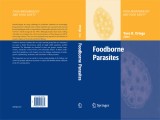Details

Foodborne Parasites
Food Microbiology and Food Safety
|
160,49 € |
|
| Verlag: | Springer |
| Format: | |
| Veröffentl.: | 22.11.2006 |
| ISBN/EAN: | 9780387311975 |
| Sprache: | englisch |
| Anzahl Seiten: | 290 |
Dieses eBook enthält ein Wasserzeichen.
Beschreibungen
<P>Microbiologists are being challenged as foodborne outbreaks are increasingly being observed worldwide. Most of these outbreaks are associated with viral and bacterial pathogens such as Campylobacter, Salmonella, and lately <EM>Escherichia coli</EM> O157:H7, which emerged in the 1990s. Although parasites have been evolving with Man since antiquity, the control and eradication of these diseases are still far from being achieved. They are more frequently being reported in the literature as causative agents of food and waterborne illnesses. </P>
<P><EM>Foodborne Parasites</EM> examines the two major parasite groups that are transmitted via water or foods: the protozoa, which are single celled organisms, and the helminths. The helminths are classified in three sub groups: cestodes (tapeworms), nematodes (round worms), and trematodes (flukes). To better understand their significance, each chapter covers the biology, mechanisms of pathogenesis, epidemiology, treatment, and inactivation of these parasites. </P>
<P>This important new text is crucial to a better understanding of the biology and control of parasitic infections necessary to reduce and eliminate future outbreaks in the U.S. and elsewhere.</P>
<P><EM>Foodborne Parasites</EM> examines the two major parasite groups that are transmitted via water or foods: the protozoa, which are single celled organisms, and the helminths. The helminths are classified in three sub groups: cestodes (tapeworms), nematodes (round worms), and trematodes (flukes). To better understand their significance, each chapter covers the biology, mechanisms of pathogenesis, epidemiology, treatment, and inactivation of these parasites. </P>
<P>This important new text is crucial to a better understanding of the biology and control of parasitic infections necessary to reduce and eliminate future outbreaks in the U.S. and elsewhere.</P>
Amoeba and Ciliates.- The Biology of Giardia Parasites.- Coccidian Parasites.- Cryptosporidium and Cryptosporidiosis.- Toxoplasmosis.- Food-Borne Nematode Infections.- Foodborne Trematodes.- Cestodes.- Waterborne Parasites and Diagnostic Tools.- Risk Assessment of Parasites in Food.
<P>Microbiologists are being challenged as foodborne outbreaks are increasingly being observed worldwide. Most of these outbreaks are associated with viral and bacterial pathogens such as Campylobacter, Salmonella, and lately <EM>Escherichia coli</EM> O157:H7, which emerged in the 1990s. Although parasites have been evolving with Man since antiquity, the control and eradication of these diseases are still far from being achieved. They are more frequently being reported in the literature as causative agents of food and waterborne illnesses. </P>
<P><EM>Foodborne Parasites</EM> examines the two major parasite groups that are transmitted via water or foods: the protozoa, which are single celled organisms, and the helminths. The helminths are classified in three sub groups: cestodes (tapeworms), nematodes (round worms), and trematodes (flukes). To better understand their significance, each chapter covers the biology, mechanisms of pathogenesis, epidemiology, treatment, and inactivation of these parasites. </P>
<P>This important new text is crucial to a better understanding of the biology and control of parasitic infections necessary to reduce and eliminate future outbreaks in the U.S. and elsewhere.</P>
<P><EM>Foodborne Parasites</EM> examines the two major parasite groups that are transmitted via water or foods: the protozoa, which are single celled organisms, and the helminths. The helminths are classified in three sub groups: cestodes (tapeworms), nematodes (round worms), and trematodes (flukes). To better understand their significance, each chapter covers the biology, mechanisms of pathogenesis, epidemiology, treatment, and inactivation of these parasites. </P>
<P>This important new text is crucial to a better understanding of the biology and control of parasitic infections necessary to reduce and eliminate future outbreaks in the U.S. and elsewhere.</P>
Serves as a reference book for students and professionals in food science as well as public health Reviews the two major parasite groups that are transmitted via water or foods: the protozoa and the helminths Includes supplementary material: sn.pub/extras

















